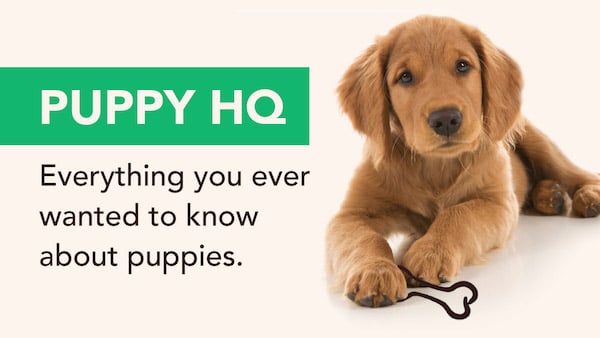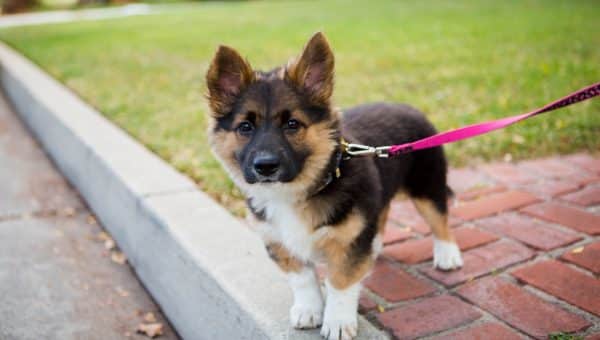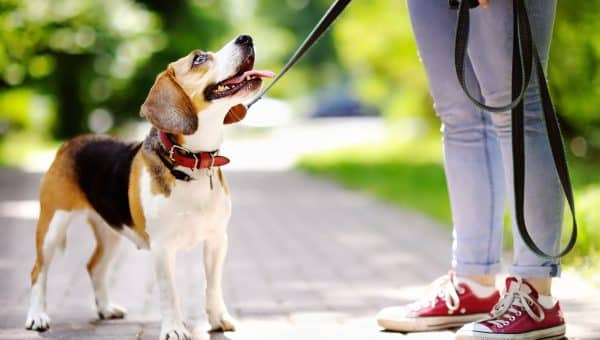- Not a substitute for professional veterinary help.
In terms of comfort and safety, walking your dog with a harness is usually the best option. Harnesses evenly distribute pressure across a dog’s body, protect their neck, and discourage pulling. But what if your dog resists wearing one?
Some dogs are sensitive to things touching their body, and others dislike gear going over their head. Some dogs may even be frightened by the clicking sound of the buckles. This can be a real headache for pet parents—but there are ways to teach your dog to love their harness.
To learn how pet parents can harness train their dogs, we spoke with Pat Miller, CBCC-KA, CPDT-KA, a behavior consultant and the director of Peaceable Paws Dog and Puppy Training. We’ll also look at solutions to some common problems along the way. Here’s your expert guide to peaceful harness training.
How To Introduce Your Dog to Their Harness
The best approach to harness training will be slow and relaxed, says Pat Miller. Dogs vary in their comfort level with a harness. Some will be at ease straight away, others may need more time to acclimate to this new equipment. The key to success is patience—not force. It’s important to go at our dog’s pace.
To help your dog view the harness as a good thing rather than a scary restraint, start with creating positive associations—before you even attempt to put the harness on.
First, simply lay the harness on the ground. Let your dog sniff and investigate it on their terms. Miller recommends sprinkling treats on the harness to encourage your dog to explore it.
When your dog appears comfortable with the harness on the floor, you can pick it up, offering a treat each time you do so. For dogs who aren’t motivated by treats, you can associate the harness with positive experiences such as affection, praise, or a favorite toy.
Miller says once your dog’s eyes light up when you grab the harness (because they know a treat is coming), they’re ready to start wearing it.

michellegibson via iStock
This process can take up to a few weeks for some dogs. To avoid setbacks in training, it’s important to monitor your dog for signs of distress that could indicate you’re moving too fast. “Avoidance is a big giveaway,” says Miller. If your dog shuts down, gets very still, or moves away from the harness, they’re telling you it makes them nervous.
Along with avoidance behaviors, watch for vocalization (whining, growling, barking) and anxious body language (cowering, tail tucking, lip licking, flattened ears). If you notice these signs, take a step back and continue working on building positive associations. Otherwise, you risk making your dog more fearful of their harness.
Putting on the Harness: Over-the-Head vs. Step-In
There are two main harness types: step-in harnesses and over-the-head harnesses. While the initial introduction will be the same for both, the process will look slightly different once we’re ready to put the harness on your dog’s body.
How to train your dog to wear a step-in harness
With a step-in harness, dogs place their front paws into the straps, then you fasten it around their body. Pat Miller breaks down the steps for getting a dog comfortable with this type of harness.
- Place the harness on the ground.
- With a treat, invite your dog to place their paws into the harness.
- Gradually raise the harness an inch or two at a time, giving treats the entire time.
- Once the harness is fully on, have a partner offer treats while you buckle the straps. If you’re training solo, Miller recommends smearing dog-safe peanut butter onto a Lick Mat to keep your pup occupied while you fasten them.
How to train your dog to wear an over-the-head harness
Some dogs get nervous with gear going over their head. To mitigate this, Miller recommends taking the following steps.
- In one hand, hold the harness in front of your dog.
- With a treat in your other hand, invite your dog to put their head through the harness opening.
- When the harness is in place, have a partner feed your dog treats while you fasten the buckles. If you don’t have a partner, Miller recommends spreading dog-safe peanut butter onto a Lick Mat to keep your pup happily engaged while you work on the straps.
It’s important to let your dog put their head through voluntarily—avoid forcing the harness onto them. For this reason, the treat lure is a permanent part of Miller’s routine. “It’s always my dog’s choice to put her head into the harness,” she says.
Resolving Common Harness Training Issues
Harness training can be challenging for some dogs. Here are some expert tips if you run into trouble.
What should I do if my dog runs away when they see the harness?
Miller explains this is a clear indication your dog is afraid of the harness. That means we need to go back to square one and (very slowly) work on changing the dog’s association. Pair the harness with high-value treats, moving forward only when you’re certain your pup is comfortable.
In some cases, a harness may not be the right equipment for your dog. “As much as we think of the harness as a positive training tool, if an individual dog finds it aversive, my first choice is to find a different training tool for that dog.” This could mean finding a different harness or maybe something entirely different, like a martingale collar or Gentle Leader.
What if my dog is frightened by the sound of the buckles snapping into place?
Noise-averse dogs may benefit from gradual counterconditioning. Start by snapping the clips at a distance. “Dogs should notice the sound but not be concerned,” Miller explains. Snap, then offer a treat. Repeat this until your dog happily looks for the treat when they hear the snapping sound.
Then, move a few inches closer and repeat the process. Miller reminds us this may take some time. Remember to be patient, and don’t rush your dog.

Ladanifer via iStock
What should I do if my dog gets the zoomies once their harness is on?
“I’d say let her zoom, if possible,” says Miller. Overexcitement isn’t uncommon: after all, the harness usually means fun things are about to happen! Miller recommends waiting until your pooch gets out their excess energy before proceeding.
If you’d like to avoid the zoomies, Miller says to put the harness on your dog several times a day and then go about your normal routine. After several minutes, take it off. This helps your dog understand the harness doesn’t always mean an adventure awaits.
How can I choose the right harness for my dog?
Like most dog gear, harnesses aren’t one-size-fits-all. To improve your chances of a positive training experience, it’s important to find the right harness for your unique pooch. First, consider your dog’s walking style. Front-clip harnesses are great for pullers, while back-clip harnesses are better for dogs who are well-behaved on walks. You can also find harnesses designed for escape artists, puppies in training, and dogs prone to chafing.
It’s also important to consider your dog’s size and body type since an ill-fitting harness can cause discomfort and limit mobility. Small dogs tend to do well with step-in harnesses, vest harnesses, and back-clip harnesses that remove pressure from their delicate tracheas. Large breeds, on the other hand, may benefit from a front-clip harness that provides better control. They also tend to do better with over-the-head models.






